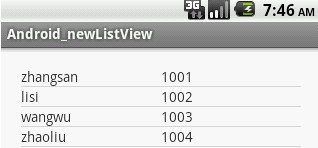首先是布局文件,这里需要两个布局文件,一个是放置列表控件的Activity对应的布局文件 main.xml,另一个是ListView中每一行信息显示所对应的布局 list_item.xml 这一步需要注意的问题是ListView 控件的id要使用Android系统内置的 android:id="@android:id/list" [注意形式]
main.xml
<?xml version="1.0" encoding="utf-8"?>
<LinearLayout xmlns:android="http://schemas.android.com/apk/res/android"
android:layout_width="match_parent"
android:layout_height="match_parent"
android:orientation="vertical" >
<ListView
android:id="@android:id/list"
android:layout_width="match_parent"
android:layout_height="match_parent"
android:padding="20dip"/>
</LinearLayout>
list_item.xml
<?xml version="1.0" encoding="utf-8"?>
<LinearLayout xmlns:android="http://schemas.android.com/apk/res/android"
android:layout_width="match_parent"
android:layout_height="match_parent"
android:orientation="horizontal" >
<TextView
android:id="@+id/user_name"
android:layout_width="match_parent"
android:layout_height="match_parent"
android:layout_weight="1"/>
<TextView
android:id="@+id/user_id"
android:layout_width="match_parent"
android:layout_height="match_parent"
android:layout_weight="1"/>
</LinearLayout>
然后就设置MainActivity中的代码了:基本思想就是先将数据添加到ArrayList中,然后在设置SimpleAdapter适配器完成设置,入下:
package com.example.android_newlistview;
import java.util.ArrayList;
import java.util.HashMap;
import java.util.Map;
import android.os.Bundle;
import android.app.Activity;
import android.app.ListActivity;
import android.view.Menu;
import android.widget.SimpleAdapter;
public class MainActivity extends ListActivity {
String[] from={"name","id"}; //这里是ListView显示内容每一列的列名
int[] to={R.id.user_name,R.id.user_id}; //这里是ListView显示每一列对应的list_item中控件的id
String[] userName={"zhangsan","lisi","wangwu","zhaoliu"}; //这里第一列所要显示的人名
String[] userId={"1001","1002","1003","1004"}; //这里是人名对应的ID
ArrayList<HashMap<String,String>> list=null;
HashMap<String,String> map=null;
@Override
protected void onCreate(Bundle savedInstanceState) {
// TODO Auto-generated method stub
super.onCreate(savedInstanceState);
setContentView(R.layout.main); //为MainActivity设置主布局
//创建ArrayList对象;
list=new ArrayList<HashMap<String,String>>();
//将数据存放进ArrayList对象中,数据安排的结构是,ListView的一行数据对应一个HashMap对象,
//HashMap对象,以列名作为键,以该列的值作为Value,将各列信息添加进map中,然后再把每一列对应
//的map对象添加到ArrayList中
for(int i=0; i<4; i++){
map=new HashMap<String,String>(); //为避免产生空指针异常,有几列就创建几个map对象
map.put("id", userId[i]);
map.put("name", userName[i]);
list.add(map);
}
//创建一个SimpleAdapter对象
SimpleAdapter adapter=new SimpleAdapter(this,list,R.layout.list_item,from,to);
//调用ListActivity的setListAdapter方法,为ListView设置适配器
setListAdapter(adapter);
}
}

另外对点击某一行作出响应的方法是覆写onListItemClick方法,根据返回的position(从0开始):
@Override
protected void onListItemClick(ListView l, View v, int position, long id) {
// TODO Auto-generated method stub
super.onListItemClick(l, v, position, id);
}














